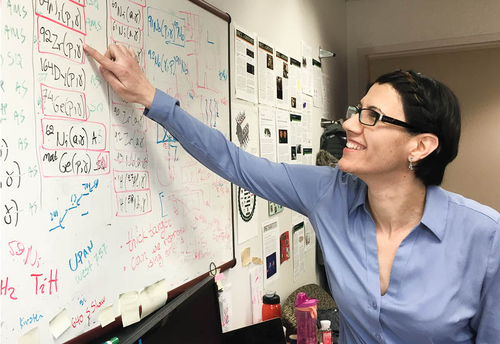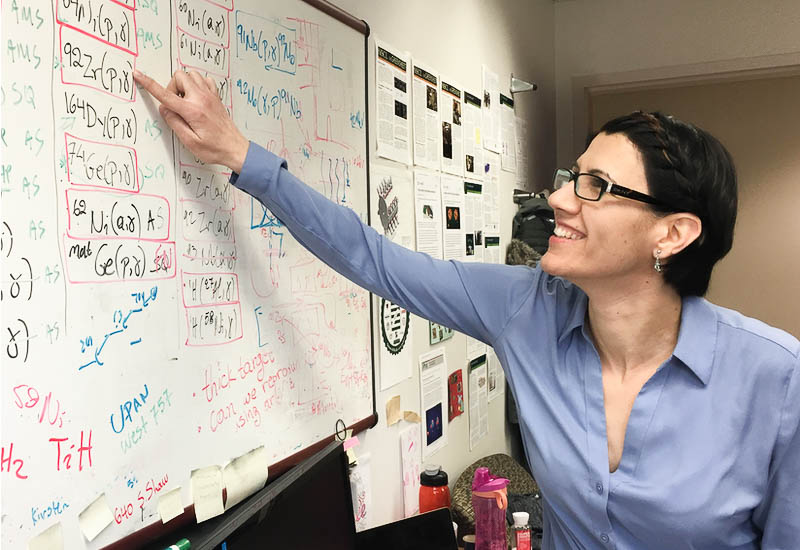Q&A: Studying the Stars—No Telescope Required
Artemis Spyrou studies the physics of stars, but she’s never used a telescope. Instead, as a nuclear astrophysicist at Michigan State University (MSU), she seeks to understand how heavy elements could be created in extreme environments like neutron-star mergers or supernovae. She focuses on a synthesis process involving neutron-rich nuclei, whose properties Spyrou explores in experiments with isotopes produced at MSU’s National Superconducting Cyclotron Laboratory. She looks forward to using the university’s soon-to-be-completed Facility for Rare Isotope Beams, where she will be able to study a much wider swath of astrophysically relevant nuclei.
Spyrou says that her research allows her to combine two loves: the hands-on experience of being in the lab and the chance to wrestle with astrophysics’ big questions. In an interview with Physics, she discussed the ongoing challenge of predicting the abundances of elements in the Universe, the boon to her field from multimessenger astronomy, and her efforts to combat public misconceptions about nuclear physics.
–Jessica Thomas
Many of your experiments are aimed at understanding the so-called r-process of producing heavy elements. What is this method and how does it work?
The r-process—or rapid neutron-capture process—produces many of the elements that are heavier than iron. It can only occur during an “explosive” event, where nuclei are likely to be bombarded with a lot of neutrons. The most likely sites for the r-process are supernovae and neutron-star mergers.
What happens is that “seed” nuclei capture neutrons quickly, one after the other, leading to sequences of neutron captures and beta decays. These sequences of reactions produce increasingly heavy and very neutron-rich nuclei (r-process nuclei), which eventually beta decay into stable isotopes after the event is over.
You’ve described the r-process as a big puzzle for your field. How so?
The puzzle is figuring out the inputs, such as the masses and neutron-capture rates, that we need to model the r-process. The majority of these nuclear properties can’t be measured with today’s technology, so the models largely rely on theory. Different theoretical calculations predict very different values for these nuclear properties, which then lead to big variations in the predicted abundances.
How are you contributing on the experimental front?
My research is mostly about measuring the neutron-capture rates of r-process nuclei. These rates are almost impossible to measure in the lab: you can’t make a target out of these nuclei and then shoot at it with neutrons—or vice versa—because the nuclei and neutrons are radioactive and transform before you can do the experiment. I’ve therefore focused on figuring out indirect ways of probing these neutron-capture reactions (see 16 June 2016 Synopsis).
The r-process involves so many nuclei, but it can take years to study just one. How do you decide where to direct your attention?
Modelers carry out “sensitivity studies” where they change the property of one nucleus in the r-process path, for example, and see if it has an impact on the predicted abundances. If it does, that provides motivation for me to make a measurement.
You’ve said that the 2017 “multimessenger” detection of both gravitational waves and electromagnetic emission from a neutron-star merger had a big effect on your field. How so?
I was jumping up and down about the discovery. Before 2017, all we had to test r-process models with were the abundances of elements left over from events that occurred millions of years ago. But in the 2017 event, researchers were able to detect the radiation emitted by the neutron-rich, exotic nuclei produced during the r-process—the first direct signature of these nuclei.
This signal gave us so much more information than we ever had before. But the detection also opened new questions.
Could you give me an example?
The detected radiation came from a big soup of elements, but we don’t know what these elements are. That’s because the spectrum is so complex: the elements are moving really fast, so the radiation they emit is shifted in wavelength and broadened. There aren’t sharp lines in the spectrum that allow one to say, “OK here’s my gold and here’s my molybdenum.” That’s where nuclear physicists come in: we provide the information to model and interpret the observations.
When it comes to media coverage, nuclear physics seems to get less attention than other branches of physics. Why do you think that’s the case?
I think people are scared of the word “nuclear.” Usually, they have heard more about the bad things—like the effects of radiation—than the good things. But there are so many beneficial applications, in medicine, archaeology, and the food industry, which uses radiation to remove harmful bacteria and preserve food shelf life, for example.
That’s why I go through the effort to do outreach—such as writing articles for the online publication The Conversation. I want to show that nuclear physics isn’t scary or dangerous. We do so much more than study energy production and weapons.
Jessica Thomas is the Editor of Physics.
Know a physicist with a knack for explaining their research to others? Write to physics@aps.org. All interviews are edited for brevity and clarity.





